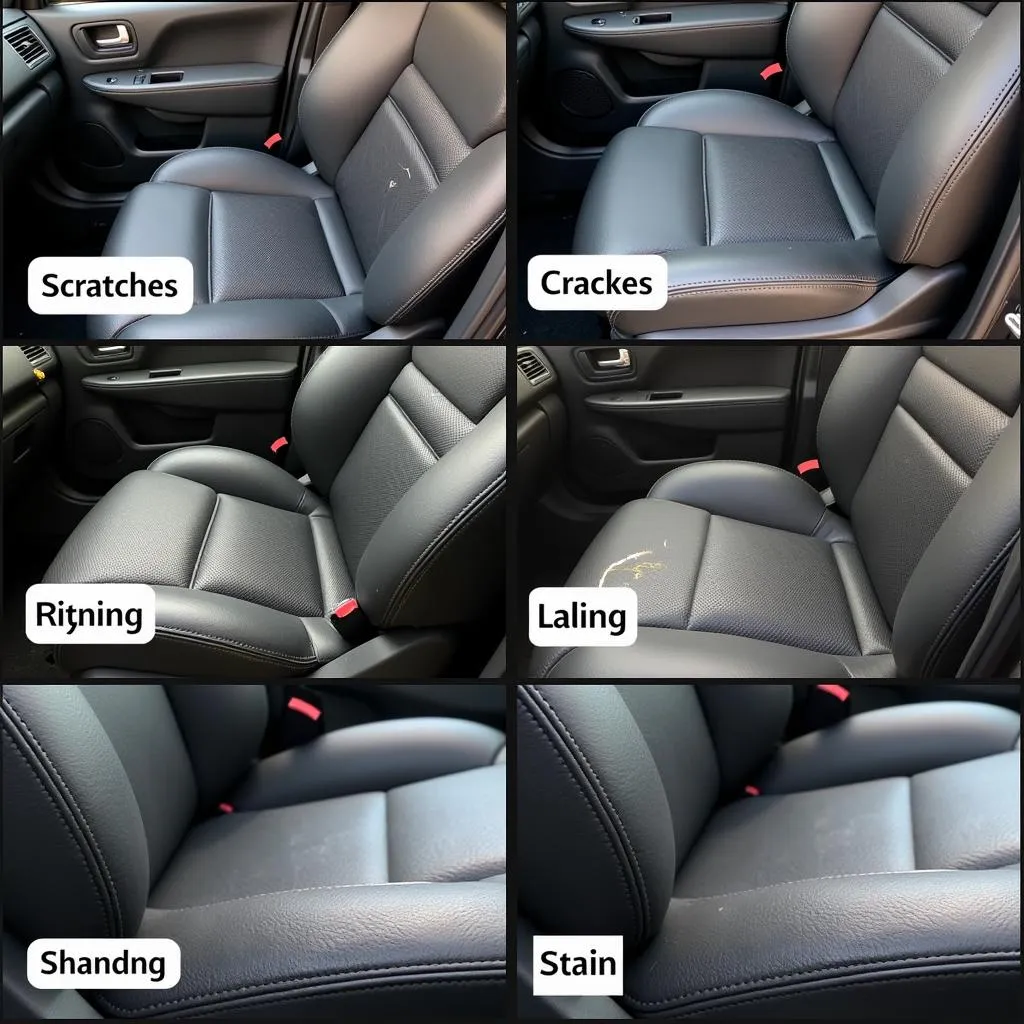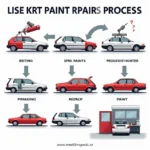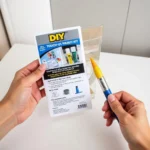Leather car seats instantly elevate a vehicle’s interior, exuding a sense of luxury and sophistication. However, the passage of time, exposure to sunlight, and regular wear and tear can leave them looking cracked, faded, and worn. Don’t despair! Knowing the best way to repair leather car seats can restore their former glory and save you the expense of reupholstery.
Assessing the Damage: The First Step to Leather Car Seat Repair
Before diving into the repair process, it’s essential to determine the extent of the damage. Is it just superficial scratches, deeper cracks, or complete color fading? This assessment will dictate the appropriate repair method and products you’ll need. For minor scratches and scuffs, a simple leather cleaner and conditioner might suffice. However, deeper cracks and color loss require more specialized leather repair kits.
DIY or Professional Leather Car Seat Repair?
Deciding between a DIY approach and calling in the professionals depends on your comfort level, the severity of the damage, and your budget.
DIY Repair: Ideal for minor scratches, scuffs, and fading. Numerous leather repair kits available cater to different colors and types of leather.
Professional Repair: Deep cracks, tears, or extensive damage might require the expertise of a professional. They possess specialized tools, knowledge, and experience to deliver high-quality results.
The Best Way to Repair Leather Car Seats: A Step-by-Step Guide (DIY)
For those opting for the DIY route, here’s a comprehensive guide to effectively repair your leather car seats:
- Clean the Area: Begin by thoroughly cleaning the affected area with a dedicated leather cleaner. This removes dirt, grime, and debris, ensuring optimal adhesion of repair products.
- Repair Cracks and Tears: For deeper cracks and tears, use a leather filler. Apply it carefully, pressing it into the damaged areas. Allow it to dry completely.
- Sanding: Once the filler dries, gently sand the area using fine-grit sandpaper. This creates a smooth and even surface for the next steps.
- Apply Leather Dye (if necessary): If the leather has faded or discolored, use a leather dye that matches your car’s interior. Apply it evenly with a sponge or applicator pad.
- Apply a Leather Sealer: Once the dye dries, apply a leather sealer to protect the repaired area and restore the leather’s natural shine.
how to repair wear on leather car seats
Choosing the Right Leather Repair Products
The success of your leather car seat repair hinges on using high-quality products designed specifically for automotive leather.
- Leather Cleaners: Opt for pH-neutral cleaners to avoid drying out or damaging the leather.
- Leather Fillers: Choose flexible fillers that can withstand the constant flexing and movement of car seats.
- Leather Dyes: Look for dyes specifically formulated for automotive leather, ensuring colorfastness and durability.
- Leather Sealers: Select sealers that provide UV protection to prevent fading caused by sunlight exposure.
black leather repair kit for car seats
Preventing Future Damage: Prolonging the Life of Your Leather Car Seats
Once your leather car seats are restored to their former glory, follow these preventative measures to keep them looking their best:
- Regular Cleaning: Regularly clean your leather seats with a dedicated leather cleaner and a soft microfiber cloth. This removes dirt and grime that can accumulate over time and lead to premature wear.
- Leather Conditioning: Conditioning your leather seats 2-3 times a year helps to keep the leather supple, preventing drying and cracking.
- UV Protection: Park your car in the shade or use a windshield sunshade to protect your leather seats from harmful UV rays that can cause fading and damage.
“Prevention is key when it comes to maintaining the pristine condition of leather car seats,” says John Smith, Senior Automotive Detailing Specialist at XYZ Auto. ” Regular cleaning and conditioning, along with UV protection, are essential practices that significantly extend the lifespan and beauty of leather interiors.”
The Cost of Leather Car Seat Repair
The cost of repairing leather car seats can vary widely depending on the severity of the damage, the type of repair needed, and whether you choose DIY or professional services.
DIY Repair: The cost of DIY leather repair kits typically ranges from $20 to $50, making it a budget-friendly option for minor repairs.
Professional Repair: The cost of professional leather car seat repair can range from $100 to $500 or more, depending on the extent of the damage.
how much does it cost to repair leather car seats
Conclusion
Knowing the best way to repair leather car seats empowers car owners to restore their vehicles’ interiors to their former glory. Whether you opt for a DIY approach or seek professional help, addressing damage promptly and implementing preventative measures will keep your leather seats looking their best for years to come.
black car seat leather repair dye
FAQs
Q: Can I use household cleaners on my leather car seats?
A: It’s best to avoid using household cleaners on leather car seats, as they can contain harsh chemicals that can dry out and damage the leather. Always use a dedicated leather cleaner that is pH-neutral and safe for automotive leather.
Q: How often should I condition my leather car seats?
A: It’s generally recommended to condition your leather car seats 2-3 times a year, or more often if you live in a hot or dry climate.
Q: Can I repair a tear in my leather car seat myself?
A: While minor tears can be repaired using a DIY leather repair kit, larger tears or those in high-stress areas are best left to professionals.
Q: How can I prevent my leather car seats from fading in the sun?
A: Park your car in the shade whenever possible or use a windshield sunshade to block out harmful UV rays. You can also apply a leather conditioner with UV protection to help prevent fading.
Q: How do I choose the right color leather dye for my car seats?
A: Most leather repair kits offer a range of colors to match different car interiors. It’s crucial to choose a dye that closely matches your car’s original leather color. If you’re unsure, it’s best to consult with a professional.
Q: How long does it take for leather car seat repairs to dry?
A: Drying times vary depending on the products used, but it’s generally recommended to allow repairs to dry for at least 24 hours before using the seats.
Q: Can I prevent future damage to my leather car seats after they’ve been repaired?
A: Yes, you can take steps to prevent future damage by regularly cleaning and conditioning your leather seats and protecting them from UV rays.
[how to repair color leather car seats with cracks](https://carrepairon.com/how to-repair-color-leather-car-seats-with-cracks/)
Do you have other questions about car repair or car diagnostics? Visit our website for more useful articles and tips!
Need personalized assistance? Contact our dedicated support team via WhatsApp: +1(641)206-8880, or Email: [email protected]. We’re available 24/7 to address your automotive concerns.



